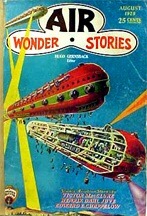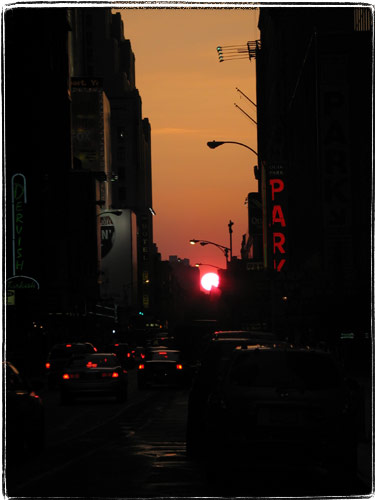
BSOD Rules The Night
Such a lyrical BSOD. Don’t you think it’s moronic to put terminals facing big glass street facing windows in a financial institution? I also like the message on the marquee display.
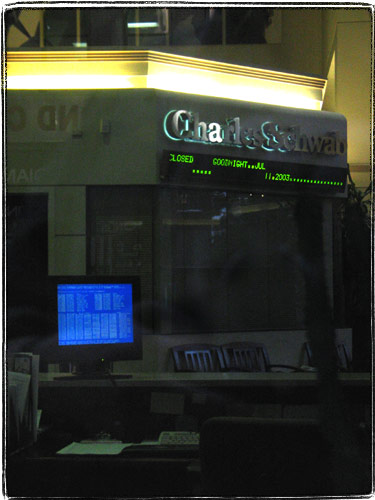
Moon Over The Paramount
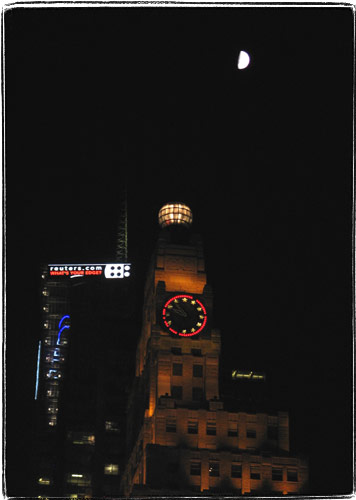
The skyscraper with the globe on top is called the Paramount Building. The building has a mountain like shape and the little stars on the illuminated clock face look like the stars on Paramount Pictures logo:

That building used to have a kick ass movie theater on the ground floor, the kind described in my favorite sci-fi story of all time, Henry Kuttner’s “The Proud Robot”. Now it houses WWF store and NY Times offices. WWF undertook an amazingly complex project of rebuilding the original theater marquee:
“Working with the New York City Landmark Commission was a prolonged challenge in replicating the historic sign. Purists on the Landmark Commissions often push for exact replications  right down to the materials involved. But Tobin & Parnes had ideas for bringing the epic sign into the 21st century using new materials and technologies.
The commission initially rejected the idea to use LED technology in 1996, but later approved the concept as more signs in the surrounding area started incorporating LEDs. “
…
Multimedia Signage Inc. in California manufactured the signage that boasts the highest resolution ever achieved. The LED pixels and cells have a .45 pitch. The highest resolution before this sign was created was .75 pitch.
…
In order to get TV quality resolution on these screens we needed to go with that .45 pitch, otherwise the resolution would only give you a clear image of someone from their shoulders to the top of their head,�? said Ms. Dibner. “Using the .45 pitch we can get almost the whole person in there.�?
…
But how do you use technology without distracting from the historical detail of the sign? It was something that many were not sure could be achieved using LED technology because the sign curved up and down. But the Landmark Commission demanded that the sign’s original curvature be replicated.
The solution: using very small diodes and arranging them to match the curve. The result: any image on the sign curves with the curvature of the marquee with no distortion, another requirement of the Landmark Commission. ”
I just love the topic of new technology meeting the old. But Landmark Commission people are nasty engineer hating snobs.
The Bastard Coworker From Hell
You think your job sucks? That’s nothing.
Parking For KRAP
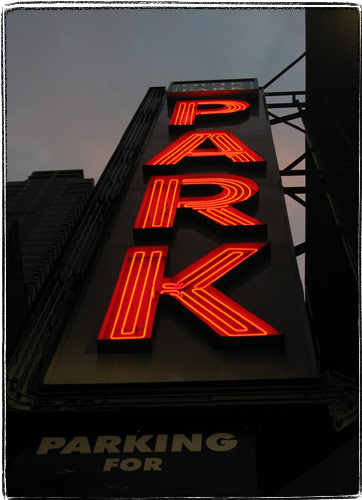
Nautical Nonsense
This ad for a new jellyfish exhibit at Brooklyn Aquarium was on the side of a bus (and the bus was moving when I took the picture). I guess the blurb applies not only to jellyfish, but also to the graphic designer who masterfully placed the Pepsi logo in that corner.

I Like Small Keyboards and I Can Not Lie You Other Brothers Can’t Deny
The perfect keyboard. A geek’s holy grail. And I am not immune to the siren’s call of this insane quest.
If you think that there isn’t much innovation in the field of alphanumeric input devices, you are in for a surprise. If you don’t think so, then you’ll be less surprised.
There are four main schools of keyboarding thought:
1) Typewriter keyboards suck , if you are really hardcore, you should use chord keysets. A chord keyset is basically a keyboard that uses combinations of buttons (like chords on a piano) to encode letters and numbers. Since fingers don’t have to travel horizontally and vertically, tremendous typing speed can be achieved. Chorded keyset is somewhat similar, but not the same as a stenotype machine used by court stenographers. According to The Straight Dope stenotype training takes 2,700 class hours (some of the classes probably have to do with understanding law terminology and the like) and you have to type 225 words per minute at 95% – 98% accuracy to pass the state exam.
Douglas Engelbart had really high hopes for his version of the keyset. Much of his research as well as The Mother Of All Demos included a setup that had a keyboard, a mouse and one handed keyset.
 A historic moment: Engelbart uses his chord keyset to delete the first Spam. |
 Closeup of a keyset, or Small Black Hit’em Bugger Teeth as it’s known in Pigin English |
The problem with chorded keyboards is the super steep learning curve and what’s even worse, the skill of typing in chords seems to quickly deteriorate without practice.
2) Then there are those who think that the root of evil is the QUERTY layout. I am yet to see a person who regularly uses Dvorak keyboard, and the whole superiority of it seems to be just a myth.
3) In the olden times there was the horror of The Space Cadet Keyboard. There were a few other devices that LISP programming aliens seemed to use. Truly bizarre geekery.
4) On the other end of the spectrum of weird keyboards are ultra expensive contraptions. Even though outrageous prices are binding this group together, the usefulness, good looks and coolness factors are all over the board for these. You have to be one rich (or fiscally irresponsible) geek to afford them. There are keyboards that are split in two, like this Kinesis keyboard that mounts on armrests.

Then there is a truly scary keyboard from the same maker that has bowl shaped indentations for keys:

This $350 keyboard has vertical set keys. I think I saw somebody’s review of it which stated that using it hurts. A lot. And I think I believe that person.

Fingerworks this $339 keyboard that has gesture recognition. Apparently

I think that all of these far out solutions are a bit too much. Split keyboards are kind of nice though. That Kinesis keyboard is 133T, but I did fine with Natural Keyboard Elite.
I also had Microsoft Natural Keyboard Pro which was discontinued (I think) is just like Elite, but with a row of buttons on top. Out of those buttons the volume control was very useful. In fact, the perfect keyboard in my opinion should have a set of buttons for volume control. I might get a Griffen Powermate for that purpose though. But at $45 it’s pricey. But cool. The rest of the soft buttons were mostly useless.
I wish I could map a button to a key combination that switches between keyboard layouts (Cyrillic and English), but that wasn’t possible with out of the box functionality. Some of the soft buttons are outright dangerous, like the crappy “sleep” button. If pressed by accident it would plunge all of your unsaved data into the buggy realm of Windows power management, the cursed ACPI.
Before then I experimented with a “clicky” keyboard. I purchased an IBM model 42H1292 aka The One True Keyboard. These Irish built mastodons capable of various feats of endurance have special spring loaded keys instead of wussy rubber membrane ones. Manly. Very manly. A click of The One True Keyboard can be heard for miles in an empty cubicle farm. But also a pain in the ass. Turned out I don’t like the clicky sound, the keys were getting stuck sometimes (even though I bought an unused, keyboard gravy free one).
Right now I am thinking of switching to a mini keyboard, like the Happy Hacking Keyboard. Right now I am typing this on a mini keyboard that my friend Dan lent me. It’s called MiniTouch. I has those IBM style clicky keys and a layout that with a little remapping could really work for me. Does anybody know a good Windows keyboard rempapper? The layout feature that I use the most is a function key that turns arrow keys into page up/down/home/end. Oh, and one thing that I do with all keyboards is turn off (by ripping out) the caps lock key. That thing is pure evil.
What’s a Good Rhyme for RSS?
Another Post from cubicle filled corridors of the Newscorp Building.
We tender this premium coffee for your enjoyment as a tribute to your good taste. It comes from the deadprogrammer’s collection to you 33.
Recently a commercial Bunn coffeemaker in our office kitchen was replaced with an automatic Keurig B2003 machine that uses K-cups. K-cups are a neat technology, but not suitable to good coffee preparation. Cffee from k-cups tastes like coffee prepared in athletic cups (because it gets very stale). On the other hand, conventional Bunn machine was actually very good, but we had the most foul prepackaged coffee. To this day I have one package of that coffee hanging on the wall of one cubicle. Check it out:
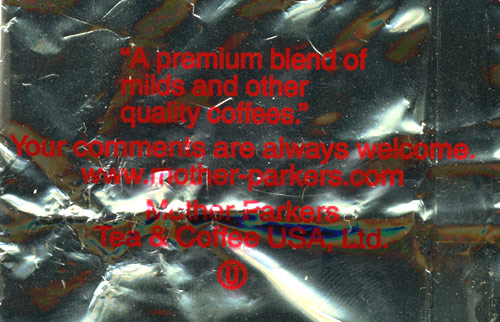
I new there was something weird in that coffee. “Milds”! What the hell are “milds”? Judging by taste it is probably tobacco. Or dried dog crap. But then, what else what did I expect from a company called “Mother-Parkers”? Hey, these motherparkers even have a website.
There is an OU symbol on the package. Milds must be kosher.
Up There In the Stratosphere
Today, when we think about science fiction, we think of rocket ships and outer space. But things were different in the 40s and 50s. Back then the blue sky was almost as exciting a frontier as the black void of space. Hugo Gernsback’s magazine Air-Wonder Stories and TV serial Zombies of the Stratosphere featuring young Leonard Nimoy were all the rage.
The word “stratosphere” was considered and became a futuristic branding element a bit less common than “o-matic” and “o-rama”. It seems to me that Boeing started this trend : B-52 Stratofortress bomber , KC-135 Stratotanker and 377 Stratocruiser. But then the marketers caught on to the hipness of everything “strato”: Sheaffer Stratowriter pen, Fender Stratocaster guitar, Pontiac StratoChief car and probably many other things that I don’t know about. Prefix “strato” was usually applied to top of the line products.
And you don’t really get any more “strato” than Zenith Stratosphere 1000Z console.
Considered by some to be the best vacuum tube radio ever produced, it is also one of the rarest. It was top of the line and cost $750 when it was made in 1930s. Times were tough, and there were not enough customers to purchase these amazing and beautiful radios. Only 350 sets were ever made, 40 are known to survive. Today 1000Z is a wet dream of any vacuum tube radio enthusiast.
What attracts me to 1000Z? Well, first of all I am a fan of vaccuum tube sound. The absolutely stunning art deco design is just gorgeous, especially the airplane style tuning dial. It looks like it belongs on a starship. This is how I imagine Henry Kuttner’s “twonky” device.
There is an interesting thing about the ads for 1000Z. As it can be seen in this ad, there is a art deco porcelain cat sitting inside the concave area of the cabinet of the radio. This led some collectors to believe that the cat was sold together with the radio. But apparently it was only used for the photo shoot. Still, people lucky enough to own a Zenith Stratosphere try to buy a cat statue to go with it.


